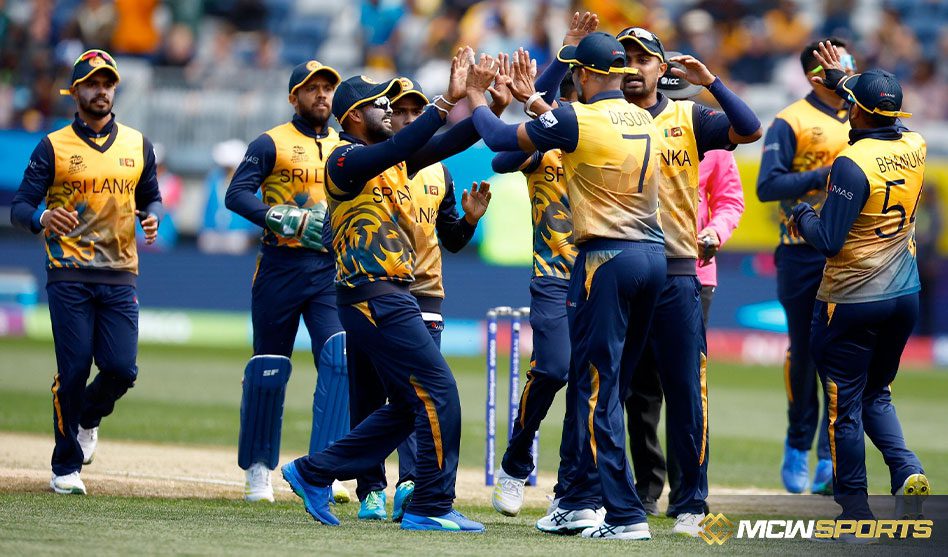This content has been archived. It may no longer be relevant
After Namibia’s game-changing late blitz with the bat, captain Dasun Shanaka was dissatisfied with his bowlers.
This was not how the story was supposed to end. The Asia Cup champions looked every bit the cut above Namibia they were meant to be during the first 15 overs of the Men’s T20 World Cup opener, and Geelong could have passed for the harbour city of Galle, save the pleasant weather.
One of the largest Sri Lankan expat populations in the world is located in Victoria, and thousands of them flocked to Kardinya Park to see their team kick off the World Cup with a party at their home away from home.
It was the Papare band. Flags of Sri Lanka were flying. As Namibia stumbled to 93 for 6 in the 15th over, Sri Lankan colors could be seen everywhere, and there was only one team receiving cheers. Even though the surface was slower than anticipated, the pace of Dushmantha Chameera and Pramod Madushan on a challenging drop-in surface was too much for a Namibia top order unaccustomed to such speeds, bounce, and seam movement.
Up until it was not, that was. The band continued to play, but Sri Lanka’s quicks cut off the chin music, and Namibia won the match from a position where winning seemed almost impossible, pulling off one of the biggest upsets in T20 World Cup history.
Namibia, on the other hand, played flawlessly after that and deservedly earned a historic victory. To set an above-average target of 164, Jan Frylinck and JJ Smit put up the third-highest seventh-wicket stand in tournament history and the ninth-highest stand in T20I history. Then, Namibia bowled and fielded like a top-tier squad to choke Sri Lanka’s hitters and dismiss them for 108 runs.
Despite the dismal batting performance, it was quite evident what went wrong in the game. Namibia had prepared for the extra bounce and pace in Australia for a whole year by training on synthetic and concrete fields. Even though the Geelong drop-in took far longer than they had anticipated, Sri Lanka’s pace bowlers troubled them greatly in the opening 15 overs with on-speed hard lengths. The only top-order batsman for Namibia to hit a six in the first 15 overs was Jan Nicol Loftie-Eaton, who cut Chamika Karunaratne over point and pulled Chameera over fine leg. All other top-order players, though, had trouble.
That was up until the final five overs, when the quicks entirely changed their strategy and began mixing in slower balls while bowling fuller, only to have Frylinck and Smit obliterate them. From the final five overs, the pair plundered 68 runs. Only once in the final three overs (17–20) of a T20 World Cup game had Sri Lanka given up more runs than they did today.
In the aftermath, Captain Dasun Shanaka criticized his quicks.
At the news conference, Shanaka commented, “I think they tried too much.” “I think it would have been different if they had stuck to that difficult length, wicket-to-wicket, like the Namibian bowlers did so incredibly effectively.
“I believe we provided many terrible balls to hit boundaries,”
Perhaps the Sri Lankan bowlers were drawn into bowling to the dimensions of the field. Similar to Adelaide Oval, Kardinya Park has short square boundaries and long straight boundaries, as well as some deep pockets at long off and long-on. These features caused Sri Lanka’s bowlers to err fuller, as Maheesh Theekshana highlighted in the game’s aftermath.
The fact that Dilshan Madushanka withdrew from the tournament on match day didn’t benefit Sri Lanka. His successor, Binura Fernando, has been called up. Lahiru Kumara could have played against Namibia to give some more pace, but Shanaka said he didn’t want Kumara and Chameera to return from serious injuries at the same time.
As a result, Sri Lanka is now exposed. The UAE or the Netherlands could be eliminated from the competition if they lose one more game. They might also advance as the second qualifier from Group A, which would place them in the Super 12s on the same side of the draw as Pakistan and India.













